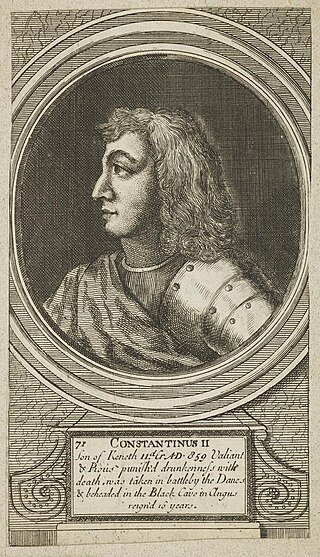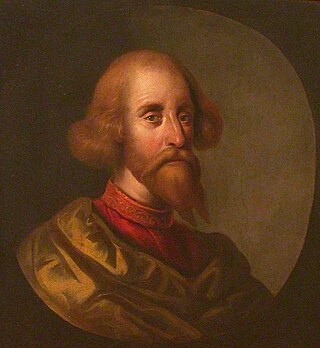
Causantín mac Cináeda was a king of the Picts. He is often known as Constantine I in reference to his place in modern lists of Scottish monarchs, but contemporary sources described Causantín only as a Pictish king. A son of Cináed mac Ailpín, he succeeded his uncle Domnall mac Ailpín as Pictish king following the latter's death on 13 April 862. It is likely that the reign of Causantín witnessed increased activity by Vikings, based in Ireland, Northumbria and northern Britain. He died fighting one such invasion.

Causantín mac Áeda was an early King of Scotland, known then by the Gaelic name Alba. The Kingdom of Alba, a name which first appears in Constantine's lifetime, was situated in what is now Northern Scotland.
Kenneth MacAlpin or Kenneth I was King of Dál Riada (841–850), and King of the Picts (848–858), of likely Gaelic origin. According to the traditional account, he inherited the throne of Dál Riada from his father Alpín mac Echdach, founder of the Alpínid dynasty. Kenneth I conquered the kingdom of the Picts in 843–850 and began a campaign to seize all of Scotland and assimilate the Picts, for which he was posthumously nicknamed An Ferbasach. He fought the Britons of the Kingdom of Strathclyde and the invading Vikings from Scandinavia. Forteviot became the capital of his kingdom and Kenneth relocated relics, including the Stone of Scone from an abandoned abbey on Iona, to his new domain.
Macbethad mac Findláech, nicknamed the Red King, was King of Scotland from 1040 until his death in 1057. He ruled during the period of Scottish history known as the kingdom of Alba.
Malcolm III was King of Alba from 1058 to 1093. He was later nicknamed "Canmore". Malcolm's long reign of 35 years preceded the beginning of the Scoto-Norman age. Henry I of England and Eustace III, Count of Boulogne were his sons-in-law, making him the maternal grandfather of Empress Matilda, William Adelin and Matilda I, Countess of Boulogne. All three of them were prominent in English politics during the 12th century.
Donnchad mac Crinain was king of Scotland (Alba) from 1034 to 1040. He is the historical basis of the "King Duncan" in Shakespeare's play Macbeth.
Donald III was King of Alba (Scotland) from 1093–1094 and 1094–1097. He was known as Domnall Bán or "Donald the Fair", anglicized as Donalbain.
Máel Coluim mac Cináeda was King of Alba (Scotland) from 1005 until his death in the year 1034. He was one of the longest-reigning Scottish kings of that period.

Cuilén was an early King of Alba (Scotland). He was a son of Illulb mac Custantín, King of Alba, after whom he is known by the patronymic mac Illuilb of Clann Áeda meic Cináeda, a branch of the Alpínid dynasty.
The Battle of Lumphanan was fought on 15 August 1057, between Macbeth, King of Scots, and the future King Malcolm III. Macbeth would die from wounds sustained in the battle, which came after his defeat at the battle of Dunsinane in 1054. According to tradition, the battle took place at Lumphanan in Aberdeenshire. Macbeth's Stone, a large boulder at the site, is said to mark the spot where Macbeth was mortally wounded. Following the battle Lulach, Macbeth's stepson was crowned King, before being killed by Malcolm who then took the throne.
Moray was a province within the area of modern-day Scotland, that may at times up to the 12th century have operated as an independent kingdom or as a power base for competing claimants to the Kingdom of Alba. It covered a much larger territory than the modern council area of Moray, extending approximately from the River Spey in the east to the River Beauly in the north, and encompassing Badenoch, Lochaber and Glenelg in the south and west.
The House of Moray or Clann Ruaidrí is a historiographical and genealogical construct to illustrate the succession of rulers whose base was in Moray and who ruled sometimes a larger kingdom, mainly the Kingdom of Scotland. An important feature of Scottish politics throughout the 11th century, they reached the height of their power with the reign of Macbeth between 1040 and 1057.

The Kingdom of Alba was the Kingdom of Scotland between the deaths of Donald II in 900 and of Alexander III in 1286. The latter's death led indirectly to an invasion of Scotland by Edward I of England in 1296 and the First War of Scottish Independence.

Owain Foel, also known as Owain Moel, Owain the Bald, Owen the Bald, and Eugenius Calvus, was an eleventh-century King of Strathclyde. He may have been a son of Máel Coluim, son of Dyfnwal ab Owain, two other rulers of the Kingdom of Strathclyde. Owain Foel is recorded to have supported the Scots at the Battle of Carham in 1018. Although it is possible that he died in the conflict, no source states as much, and it is uncertain when he died. Owain Foel may be an ancestor—perhaps the father—of a certain Máel Coluim who is described as the "son of the king of the Cumbrians" in the 1050s.
Amlaíb mac Illuilb was a tenth century King of Alba. He was one of three sons of Illulb mac Custantín, King of Alba, and a member of Clann Áeda meic Cináeda, a branch of the Alpínid dynasty. Amlaíb's paternal grandfather possessed strong connections with the Scandinavian dynasty of Dublin, and there is evidence to suggest that Illulb and Amlaíb bore names of Old Norse origin. If Amlaíb's name indeed represents a Gaelicised Scandinavian name, it could indicate that his mother was a member of the Uí Ímair, and possibly a granddaughter of Amlaíb Cúarán or Amlaíb mac Gofraid.

The Battle of Dollar was fought in 875 at Dollar, Scotland, between Viking invaders under Halfdan Ragnarsson and the defenders led by King Constantine I. The Vikings had previously been part of the Great Heathen Army which had been assaulting the Anglo-Saxon kingdoms of England before moving to a base by the river Tyne to raid the lands of the Picts and Strathclyde Britons.
Christian or Christina Bruce, also known as Christian or Christina de Brus, was a daughter of Marjorie, Countess of Carrick, and her husband, Robert de Brus, jure uxoris Earl of Carrick, as well as a sister of Robert the Bruce, King of Scots. It is presumed that she and her siblings were born at Turnberry Castle in Carrick.
Domnall mac Áeda, also known as Domnall Dabaill, was a King of Ailech. He was a son of Áed Findliath mac Niall, High King of Ireland. Domnall was a half-brother of Niall Glúndub mac Áeda, a man with whom he shared the kingship of Ailech. From Domnall would descend the Mac Lochlainn dynasty.

The Battle of Dunsinane, also known as the Battle of the Seven Sleepers, was fought between the forces of Macbeth, King of Scotland and forces led by Siward, Earl of Northumbria and Malcolm Canmore on 27 July 1054. The battle was part of a campaign launched by Siward in support of Malcolm's claim to the Scottish throne, which Macbeth had gained after killing Malcolm's father, Duncan I of Scotland, at the Battle of Pitgaveny in 1040. Ending in victory for Siward and Malcolm the battle of Dunsinane was fought in Perthshire, traditionally on Dunsinane Hill.








